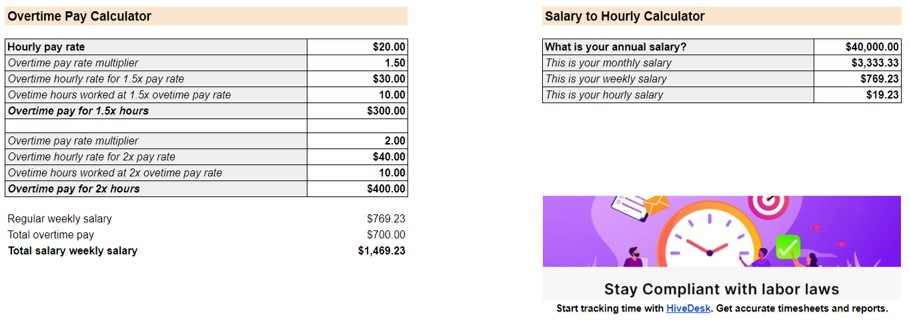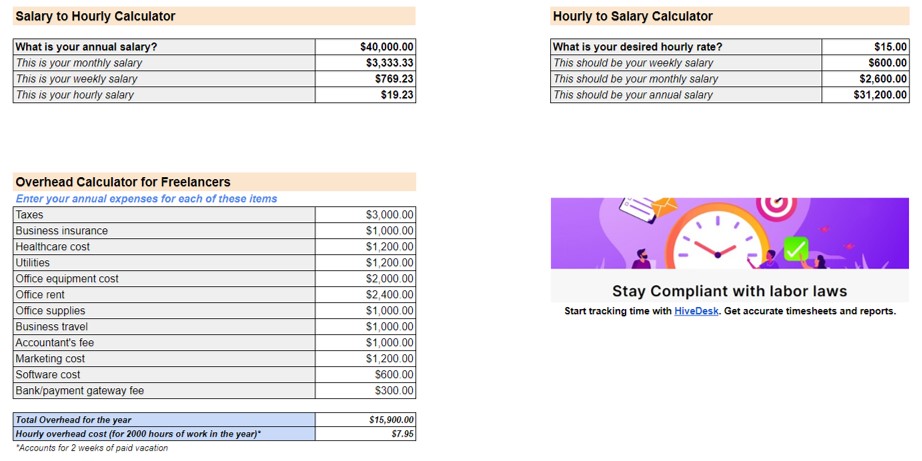Overtime Calculator
Use this calculator to calculate overtime wages for both salaried and hourly employees. Calculate overtime pay for both 1.5x and 2x pay rate as required by California.
Overtime calculator helps you find out how much you will earn (or need to pay) in overtime wages for extra hours worked.
For any business, managing employee overtime is one of the most important and challenging tasks. Keeping track of the amount of hours worked, allocating overtime pay, and ensuring compliance with labor regulations can be overwhelming.
Fortunately, an overtime calculator can help simplify this process. An overtime calculator takes all the guesswork out of managing overtime, allowing employers and HR managers to quickly and accurately calculate overtime pay for their employees.
With an overtime calculator, businesses can save time and money, while ensuring their employees are paid accurately and on-time.
The ability to quickly and easily calculate overtime pay is an essential tool for any business looking to stay compliant with labor regulations and maximize the efficiency of their payroll.
Easily manage your workforce
Track employee time, tasks & projects with HiveDesk. View & approve timesheets, manage project cost and increase team productivity.
Employee time tracking
Track employee time with our desktop, mobile and browser apps
Task management
Create and assign tasks to employees. Track task time, schedule, and status.
Project tracking
Track project status, hours spent, and labor cost incurred on the project
Timesheet & Timecard
Get accurate employee timesheets & timecards with approval process
Multi-level access management
Assign manager role to employees with different level access control
Project cost tracking
Track labor cost incurred on each task & project by adding hourly cost for each employee
Automatic screenshots
Capture periodic screenshots for feedback & monitoring
Workforce Management
Add and remove employees. Manage roles, tasks, attendance and track time.
Geolocation tracking
Track location of field employees to generate location based timecards
Works on any device
Works on Windows, Mac, Linux, iOS, Android, and Chrome browser
Track field employees
Track field employees with the mobile app. Manage tasks and track time by location
Detailed reporting
See important employee, project and business metrics in detailed reports.
What is overtime work?
Overtime work is defined as any hours worked beyond the standard working hours. Generally, the standard working hours are 40 hours per week, however, this may vary depending on the job and the country.
Overtime is often paid at a higher rate than the regular rate, to compensate for the extra hours worked. It is important to note that overtime work should not be considered as a way to increase income, as it can become a burden if worked too much.
It is also important to consider the impact overtime work can have on an individual’s health and wellbeing, as lack of rest and leisure can have a negative effect.
Therefore, overtime work should be considered carefully, and workers should be aware of their rights regarding overtime and their rights to rest and leisure.
What is an overtime calculator?
An overtime calculator is a tool used to calculate the pay of an employee who has worked more than the standard allotted hours in a given week or month.
It is a simple yet effective way to ensure that employees are paid accurately and fairly for overtime work. Overtime calculators are a useful tool for businesses and can help them to stay on top of their payrolls, as well as ensure that their employees are always receiving the correct amount of compensation for their extra hours of work.
This type of calculator is a great asset to any business and can save them time and money in the long run.
What is the overtime pay rule in the USA?
The US overtime pay rule states that all workers must be paid time-and-a-half for any hours worked over 40 in one workweek. This means that any non-exempt employee who works more than 40 hours in one week must be compensated at 1.5 times their regular rate of pay for any hours worked over the 40-hour threshold.
Employers must also pay overtime to part-time employees, seasonal employees, and temporary employees, so long as they fall under the non-exempt category and work more than 40 hours within the one-week period.
Overtime pay must be paid in cash or, if the worker agrees, comp time. All employers must adhere to the overtime pay rule and failure to do so may result in legal action.
How to calculate overtime pay for non-salaried employees?
Calculating overtime pay for non-salaried employees can be complicated, but it is important to ensure compliance with labor laws such as Fair Labor Standards Act.
To calculate overtime pay, an employer must first determine the employee’s regular rate of pay. This rate is calculated by dividing the total earnings divided by the total hours worked during the pay period.
Once the regular rate of pay is determined, employers must pay overtime pay of one and a half times this rate for any hours over 40 during a workweek.
Employers must also ensure that they are paying the correct minimum wage, as overtime pay cannot be below the applicable minimum wage. It is important to keep accurate records of employee hours and pay to ensure that all applicable laws are being followed.
How to calculate overtime pay for salaried employees?
Calculating overtime pay for salaried employees is an important part of payroll management. It is important to understand the legal regulations and laws in place to ensure proper calculation.
Generally, salaried employees are exempt from overtime pay. However, there are certain situations where the employee may be entitled to overtime.
To calculate overtime pay for salaried employees, the employer must first determine if the employee is entitled to overtime pay. If so, the employer must calculate the overtime rate based on the employee’s base salary. The overtime rate is typically 1.5 times the normal rate for hours worked over 40 in a given week.
Once the overtime rate is established, the employer can then calculate the total overtime pay for the employee by multiplying their overtime rate with the number of overtime hours worked.
It is important to ensure accuracy and compliance with legal regulations and requirements when calculating overtime pay.
Who is eligible for overtime pay?
Under the Fair Labor Standards Act, most employees are eligible for overtime pay if they work more than 40 hours in a single workweek. Employees must be at least 18 years old and not considered a minor.
Exceptions to this rule may apply, such as employees who are exempt from overtime pay due to their job duties, or certain salaried workers who are classified as “exempt” from overtime pay.
In general, however, most employees are eligible for overtime pay if they work more than 40 hours in a single workweek. Employers should be aware of their obligations to pay their employees overtime wages and should ensure that they are following the guidelines set forth in the Fair Labor Standards Act.
What is California overtime rule?
The California overtime rule requires employees to be paid at least 1.5 times their regular rate of pay for any hours worked beyond 8 in a day or 40 in a week. The overtime rate applies to all non-exempt employees, regardless of the type of industry or occupation.
This overtime rule is based on a federal statute and applies to all employers in California who have more than 5 employees. Furthermore, the California overtime rule does not distinguish between full-time, part-time, or temporary employees. All non-exempt employees must be paid the overtime rate of 1.5 times the regular rate when they work more than 8 hours in a day or 40 hours in a week.
The overtime pay rate is double the employee’s regular rate of pay for all hours worked in excess of 12 in any workday and for all hours worked in excess of eight on the seventh consecutive day of work in a workweek. Employers must follow the California overtime rule to ensure they are in compliance with state law.
Example of jobs that are exempt from overtime pay in the US
In the United States, certain jobs are exempt from overtime pay due to their special characteristics. These include executive, administrative, professional, outside sales, and computer-related positions.
Employees in these roles generally have greater responsibility and remuneration, and are expected to work outside of typical business hours if necessary.
Additionally, certain employees classified as “bona fide” executive, administrative, or professional personnel, and certain employees in the computer and creative fields may be exempt from overtime pay. Employees in these positions are typically expected to exercise independent discretion and judgment in their work, and are given substantial latitude in their work schedules.
Use our other calculators
We have created many more calculators to help you calculate working hours, wages, and overtime:
Track time, see what employees are doing and increase productivity with HiveDesk
Employee time tracking
Track time employees spend on each project
Automatic timesheets
Pay for hours worked with automatic timesheets
Task management
Create, assign and manage tasks
Activity monitoring
See when team members are actively working

